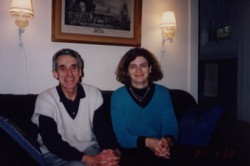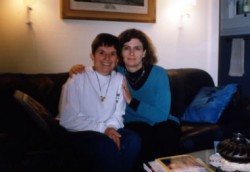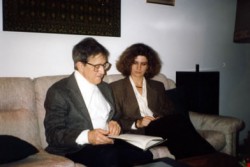 With Gil Miranda, one of my first music teachers, Oberlin, Ohio, USA, 2002. |
 With Sharon Miranda, Gil Miranda’s wife, also one of my first music teachers, Oberlin, Ohio, USA, 2002. |
At age three I was introduced to movement, painting, and music. The first of these happened in my mother’s ballet school, the Estúdio Escola de Dança Clássica de Anna Mascolo. There, I emulated flowers, insects, clouds, etc., and explored feelings through motion and gesture. As I aged, movement classes gave way to formal ballet apprenticeship. I soon realized that body control and flexibility enhanced my overall performance of daily tasks (including practicing and performing at the piano). My painting classes in the studio of Cecília Menano were plain fun! Even though I had limited talent for expression through the visual arts, I enjoyed attempting to draw people, animals, flowers, and landscapes. The people in my drawings often looked more like toothpicks with awkward limbs, and my cats and dogs resembled extra-terrestrial creatures. But as long as my imagination had an outlet, I was happy. Music, however, was the only means of expression that had the ability to carry me into deeper states of mind. The sounds produced by the piano and the feeling of its keys under my fingertips fascinated me from the start. At the piano, I felt comfortable expressing my innermost feelings with complete freedom, and living otherwise unlivable fantasies. The instrument became a close friend of mine, an accomplice in the creative process.
I attended the Saint Cecília Music Academy in Lisbon, starting at age three, where my main teachers were Gil and Sharon Miranda. After loosing touch with them for several decades, I recently learned that they had relocated to the USA many years ago. Gil served on the music faculty at the Oberlin Conservatory of Music, in Oberlin, Ohio, until his retirement in 2002. At age six, I began formal piano studies with Professor Noémia de Brederode, in Lisbon. Her love of music was so exhilarating and contagious, that I couldn’t help but feel the same way. I later enrolled in the National Conservatory, where I continued to study with Professor Brederode. Two years before graduating from the Conservatory, I began private lessons with Professor Tania Achot, who introduced me to a different technical approach to the piano. Whereas Professor Brederode favored a method based on a steady arm and active articulation of the fingers, Professor Achot focused on the arm weight and the independence of the fingers. In the meantime, I transferred to the Oporto Conservatory of Music, where I received the diploma in piano with honors. I left Portugal in 1982 to attend the University of Kansas because, at that time, there were no institutions of graduate education in music performance. At Kansas, I earned my Doctor of Musical Arts degree, under the guidance of Sequeira Costa, who studied with Mark Hamburg, Edwin Fischer, Marguerite Long, Jacques Février and Vianna da Motta (one of the last pupils of Franz Liszt and Hans von Bülow).
 Graduate Doctoral Hooding Ceremony, with Dr. J. Bunker Clark, at the Leeds Center, University of Kansas, Lawrence, Kansas, USA, 1997. |
Later, still in the USA, I studied with Edna Golandsky in New York City, and Joseph Gurt of Eastern Michigan University, two of the leading proponents of the Dorothy Taubman’s approach to piano technique. Dorothy Taubman spent over forty five years studying and researching piano pedagogy, and developed a piano technique based on the scientific understanding of the human body and of the laws of motion.I met both Edna and Joe in 1991, during one of the annual Dorothy Taubman Piano Institute workshops, in Amherst, Massachusetts. Due to the pressures of building a vast repertoire in little time, and to practicing many consecutive hours without proper awareness of the alignment of arm and hand movements, I developed severe tendonitis. To my dismay, I realized that, unless I changed my technique entirely, I would never be able to play the piano again. The Taubman lessons enabled me to return to playing and to improve and strengthen my technical skills considerably. I have been pain-free ever since I attended the workshop in 1991, and have also learned repertoire that, prior to that time, I had considered beyond my reach.

